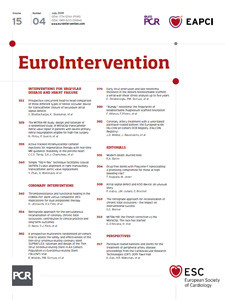
There can be few specialties that have as much to do with sudden death as cardiology. This is particularly true in parts of the world where cardiologists also work as critical care specialists and run intensive care units. While we often experience the satisfaction of working in a team that brings a patient back from the edge, so that they can be discharged back to a normal life, we are also in the frontline when it comes to dealing with sudden deterioration in previously well individuals, often deciding when further treatment would be futile and in breaking this news to relatives.
This was recently brought home to me when I had to make the decision to terminate resuscitation in a young woman who had just given birth. Shortly after delivery, she became haemodynamically unstable and rapidly deteriorated into cardiac arrest. Unfortunately, she had given birth in a small private maternity clinic and the crash call took the form of a 112 (or 999) call to activate the emergency medical services. The patient was transported through the city undergoing mechanical resuscitation to the shock room of the university medical centre. Here, despite the Herculean efforts of the shock team and the insertion of a veno-arterial extracorporeal membrane oxygenation system (ECMO) by the cardiology team, we were unable to stabilise the patient and reverse the downward spiral towards death. After protracted resuscitation efforts, we had to admit defeat. There can hardly be a more distressing set of circumstances in which to break the news that the patient has not survived. I was reminded of this case again recently when reading about the devastating impact of peripartum death in Adam Kay’s excellent memoir and bestseller, “This is Going to Hurt: Secret Diaries of a Junior Doctor”1.
Developments in resuscitation and medical device technology over the last decades have given us unprecedented ability to alter the trajectory of patients who are rapidly deteriorating towards death. While this has undoubtedly resulted in improved patient survival, the net result is that the line between life and death becomes blurred and new ethical issues emerge and become more challenging to deal with. Some of these issues are touched upon in another book, “Modern Death” by Haidar Warraich2. He notes that as recently as the 1950s cardiopulmonary resuscitation (CPR) did not exist at all. He details the progress made with airway management, mentioning the experiments of Peter Safar in defining that the airway was best maintained by laying patients on their backs with their chin lifted and head tilted backwards3. He also references the work of Paul Zoll in his initial case series of patients treated with external defibrillation4. The final piece in the jigsaw of CPR was closed chest cardiac massage. It was not until the 1960s that progress based on airway management and ventilation, external defibrillation, and chest compressions was combined into one resuscitation protocol5, which shares much in common with the protocols that we continue to use today6.
One consequence of advanced life support was that death was more difficult to diagnose. Indeed, diagnosing death is one of the core competencies of a physician, though arguably one in which training could be improved. Many of us, I am sure, can still recall vague trepidation the first time we were called to pronounce death. Interestingly, criteria for diagnosing death show substantial variation from country to country. Absence of pulse, respiratory effort and brainstem reflexes over a particular time period are sufficient in some countries. In other countries, irreversible signs of death must be documented including postmortem lividity and rigor mortis7. Dilemmas that arose from the progress in resuscitation and life support in the 1950s and 1960s required new criteria for the diagnosis of death. The need was accentuated by the advent of transplant surgery and the possibility that the organs of deceased patients could be used to prolong the life of others. A new term – brain death – was defined. Guidelines for its diagnosis were developed by medical professional associations and its presence became accepted as proof that the patient was dead8.
More recent developments in resuscitation science are also changing clinical practice and throwing up new issues for us to deal with on a daily basis. The development of external mechanical chest compression devices has made it easier to perform prolonged out-of-hospital resuscitation9. As a result, we are often faced with patients with extreme physiological derangement after prolonged resuscitation episodes, which previously would have ended in futility in the prehospital setting. Moreover, how to best manage patients after return of spontaneous circulation – in whom strong evidence of acute myocardial infarction is lacking – is a matter of equipoise, and whether or not such patients should proceed direct to catheterisation is the subject of a number of recent and ongoing clinical trials (e.g., the TOMAHAWK trial, www.clinicaltrials.gov, identifier: NCT02750462).
In parallel, the increased availablity of mechanical circulatory support with ECMO has made it possible to extend resuscitation in patients who reach hospital without return of spontaneous circulation10. Indeed, some areas have ECMO teams who will travel to out-of-hospital calls and implant circulatory support systems in the field - in some case reports in an actual field, or in the patient’s bedroom11. The availability of heroic measures means that as frontline physicians we are increasingly faced with a dilemma, especially in young patients with shock and ongoing mechanical resuscitation, as to whether to proceed direct to ECMO implantation in order to buy time for further diagnostic efforts and targeted interventions. This can result in futile attempts to save patients with underlying, undiagnosed catastrophic events.
Even in the setting of acute myocardial infarction associated with cardiogenic shock, weighing up the pros and cons of advanced mechanical circulatory support is challenging. Recent trial evidence has shown us that many mechanical approaches failed to arrest the descent down the slippery slope to death. For example, we now generally avoid the placement of intra-aortic balloon pumps, and the value of other mechanical circulatory support devices is unclear. Indeed, faced with such challenges, Petr Widimsky recently asked whether mechanical circulatory support was in many cases “harm without benefit” and, whether “fascinated by devices, cardiologists may lose common sense”12. We can at least be reassured that systematic evaluation in clinical trials is ongoing for some indications and will inform whether resource-intensive high-staffing demand interventions can affect survival (e.g., the EUROSHOCK trial, www.clinicaltrials.gov, identifier: NCT03813134).
Warraich also describes how the rapid progress in resuscitation highlighted issues around post-resuscitation care and the right to die. In the USA this issue came to a head publicly in a court case in the 1970s, which received widespread attention in the medical and lay media. The case centred on a 21-year-old called Karen Quinlan who collapsed and stopped breathing after taking alcohol and tranquillisers on 14 April 1975. The emergency medical services were called and she was resuscitated and ventilated. However, it soon became clear that her chances of recovery were very poor, as she had suffered significant neurological damage. A protracted series of court cases was set in chain to establish whether she had the right to have care withdrawn. Ultimately, this case was a landmark for patient autonomy and the right to have supportive treatment discontinued and is still referred to in judgements on contemporary disputes.
As if the blurred lines and ethical dilemmas around life and death were not challenging enough, a paper in Nature from April 2019 reported on the restoration of brain function in pigs, hours after death had been established13. Results of the BrainEx study describe restoration of certain structural and functional properties in pig brains up to four hours after the animals had been killed. These provocative findings challenge assumptions that irreversible brain damage occurs shortly after (i.e., within minutes of) circulatory arrest. This may have implications for the diagnosis of death in some situations. In particular, donor harvest protocols after futile resuscitation in patients with circulatory criteria for death – but who do not meet the criteria for brain death – might be affected. These protocols – drawn up to conform with the dead donor rule – mandate doing nothing for five to 20 minutes before steps are initiated to preserve organs. However, if it can be demonstrated that brain function could potentially be restored, the authors of an accompanying commentary article provocatively suggest that people could become candidates for brain resuscitation rather than for organ donation14.
It may well be that there is more uncertainty regarding the boundary between life and death than we like to acknowledge. In another passage in “This is Going to Hurt: Secret Diaries of a Junior Doctor”1, I was at least comforted to learn that, when a pope dies, matters are somewhat clearer. According to Vatican protocol, the author notes, the doctor has to call out the pope’s name three times, check that his breath does not blow out a candle, and then, just to be certain, he bops him on the head with a silver hammer.

